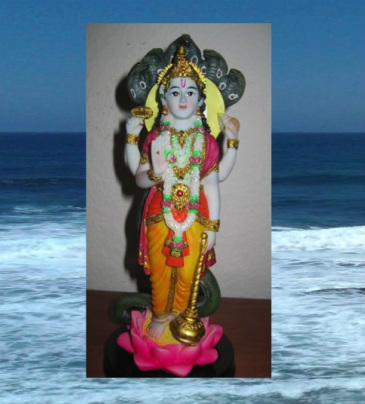|| Om Dhanvantaray Namah ||
Ayurveda is an ancient science of healing. The word Ayurveda is derived from two words: Ayush means life and Veda means knowledge. Ayurveda literally means the science of life!
Hita hitam sukham dukham ayus tasya hitahitam |
Mana ch tachha yatrokatam ayurveda sa uchyate || Ch. Su.
This shloka from Charak Samhita means: Ayurveda is a science that describes the advantageous, disadvantageous, happy and unhappy states of life , in addition to what is good and bad for life and its measurement.
This ancient science deals with not only longevity but also with maintaining good healthy body and mind.
Ayurveda is a science of body and mind. Ayurveda embraces health of body as well as mind.
Swasthasya swasthya rakshanam Aturasya vyadhi parimoksha |
Ayurveda shows different ways to maintain health of a person and also the different ways to cure a diseased person. Hence it is a complete science that helps the healthy as well as the sick person.
Ayurvedic philosophy is based on "shad darshan" or the six philosophies of life, which were developed by the ancient sages from India. Many of the scriptures are from Vedas which are almost 10,000yrs old. These Vedas have their Upavedas or additional Vedas.
Rigveda – Science of life
Yajurveda – Science of archery
Atharvaveda – Science of architecture
Samaveda – Science of music
Some scholars feel like the origin of Ayurveda is from Rigveda but some believe its origin is in Atharvaveda.
Vedas are the supreme pure knowledge. Initially Lord Bramha gave this divine knowledge to Daksha Prajapati, who passed this to Ashvin. The Ashvin twins taught this to Indra, who passed it on to Atreya and so on. This guru shishya parampara was how many rishis acquired this divine knowledge. In the initial series of this parampara, knowledge was passed on from Guru to his disciple(s) in the form of oral tradition of rote memorization of shlokas or verses. Later, this knowledge was written down and took the form of the various samhitas described below.
The Great Triad of Ayurveda (Bruhat Trayi)
Minor Tiad of Ayurveda (Laghu Trayi)
These major and minor triads of Ayurveda are the best sources of written ayurvedic knowledge.
We worship Lord Dhanvantari, the father of Ayurveda. He first appeared during the great churning of the cosmic ocean of milk that was described as Samudra manthan in Vedic philosophy, to deliver amrit or the Divine nectar. Lord Dhanvantari is described as holding a conch, leeches, healing herbs, a chakra (one of the divine weapons of Lord Vishnu) and the long sought pot of ambrosia. It is written in the Vedic scriptures that, “One who remembers the name of Dhanvantari is released from all disease.” Lord Dhanvantari is worshipped all over India as the Lord of Medicine.
On the occasion of this new year's day of 2013, we offer our humble prayers to Lord Dhanvantari and seek his blessings for health, happiness, prosperity and spirituality in life. May He bestow on us knowledge, compassion, understanding and insight for the practice of this ancient science.
The Great Triad of Ayurveda (Bruhat Trayi)
- The oldest ancient text on Ayurveda is Charaka Samhita, which is written by Acharya Charak around 400 CE. Acharya Charak is called as the father of Ayurvedic medicine.
- Sushrut Samhita is written by Acharya Sushruta, father of Ayurvedic surgery and explains detailed human anatomy. He described various surgeries including plastic surgery. Acharya sushruta has followed Dhavantari sampradaya i.e. school of surgeons.
- Ashtang Hridaya is written by Acharya Vagbhata around 6th century CE.
Minor Tiad of Ayurveda (Laghu Trayi)
- Madhavnidan was written by Acharya Madhav around 7th-8th century AD. It is the best compilation for diagnosis or roga vinishchaya.
- Sharangdhar Samhita written by Acharya Sharangdhara around 1226 AD. He has described various prescriptions, formulation of herbs and mineral pitch.
- Bhavprakash Samhita written by Acharya Bhavmisra around 1558 AD. He has described old as well as new diseases in his book.
These major and minor triads of Ayurveda are the best sources of written ayurvedic knowledge.
We worship Lord Dhanvantari, the father of Ayurveda. He first appeared during the great churning of the cosmic ocean of milk that was described as Samudra manthan in Vedic philosophy, to deliver amrit or the Divine nectar. Lord Dhanvantari is described as holding a conch, leeches, healing herbs, a chakra (one of the divine weapons of Lord Vishnu) and the long sought pot of ambrosia. It is written in the Vedic scriptures that, “One who remembers the name of Dhanvantari is released from all disease.” Lord Dhanvantari is worshipped all over India as the Lord of Medicine.
On the occasion of this new year's day of 2013, we offer our humble prayers to Lord Dhanvantari and seek his blessings for health, happiness, prosperity and spirituality in life. May He bestow on us knowledge, compassion, understanding and insight for the practice of this ancient science.
|| Hari Om ||


 RSS Feed
RSS Feed
